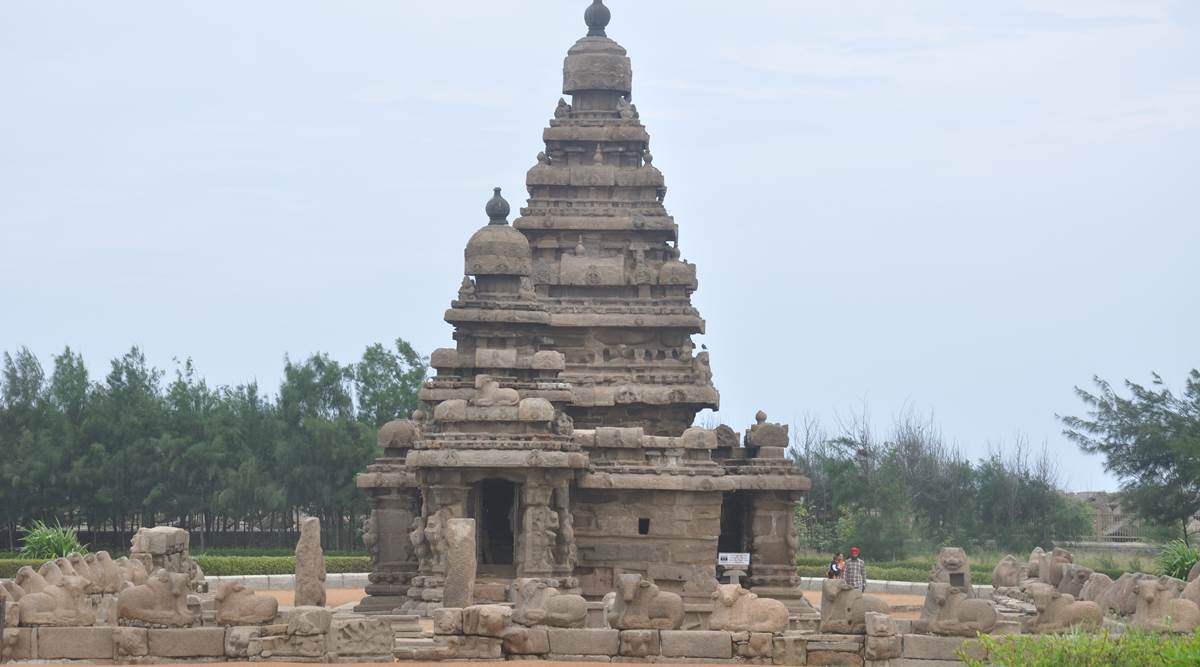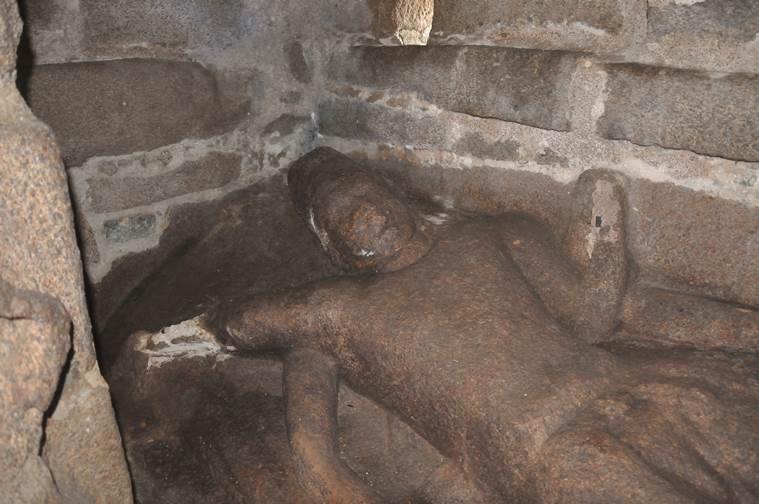Know your monument: Religion and politics in Mahabalipuram’s Shore Temple

In the 14th edition of this series on Indian monuments by Sahapedia, we consider the ways in which the architecture of the Shore Temple in Mahabalipuram, Tamil Nadu, developed through the seventh and eighth centuries CE, and its relations with religion and politics.

By Paritosh Kanoria, Sahapedia.org
It is common for monuments like the Shore Temple in Mahabalipuram to raise questions in the minds of those who visit them. How was the architecture planned so perfectly? How was it made without modern machines? Questions like these surface automatically and yet we rarely pursue them. Maybe we find it easier to accept these monuments as mysteries. Maybe not knowing adds to their charm. Or, maybe, we think that their time has passed and that they have nothing to say about our lives today. But that is not true. Let us see how understanding—and not just praising—the remains from our past (like the Shore Temple) can help us better understand religion and politics in society today.
Mahabalipuram is a coastal town in Tamil Nadu that served as an important trading port for many centuries, especially in the first millennium CE. Although the art and architecture of various dynasties and time periods can be found here, it is dominated by monuments commissioned by the rulers of the Pallava dynasty, mostly between 600 and 800 CE. Notable examples include the Pancha Rathas, Mahishasuramardini cave, Varaha cave and Arjuna’s Penance. The most famous is the Shore Temple, which is commonly attributed to the ruler Rajasimha, who ruled from 700 to 728 CE. But dating the temple is not so straightforward; it is, at its core, a question of religion and power.
The Shore Temple is made of three shrines: one dedicated to Vishnu, sandwiched by two larger ones for Shiva. This structure is quite unusual because both the Shiva shrines face different directions. Moreover, the Vishnu shrine is deprived of a tower like those over the Shiva shrines. How do we explain this design? Maybe Rajasimha was especially fond of it, but his other major and more elaborate temple at Kanchipuram displays a more traditional layout. Is there a more compelling reason for the Shore Temple’s unique form?
ALSO READ | Know Your Monument: ‘Taj of Haryana’,the Tomb of Sheikh Chilli
All three shrines—two for Shiva and one for Vishnu—are structural. This means that they were built by balancing evenly shaped blocks of stone over one another (like a brick wall but without mortar). The technology required to make structural monuments is quite advanced, which means that these shrines were made at a later date. But later than what? This is where it gets interesting. There is an element in the Shore Temple that was created using a simpler technology, before the structural shrines—the image of Vishnu (c. 600 CE). It was made using the ‘rock-cut’ technique, that is, by cutting into free-standing rock and letting forms emerge. The Vishnu image was cut directly into the granite bedrock (the ground by the coast).
The precise date of the rock-cut Vishnu is not clear but it was likely made a full century before Rajasimha’s Shiva shrines were built. This means that they were then built around the pre-existing rock-cut Vishnu, their form adapted for this purpose. But why didn’t Rajasimha choose another location for the Shore Temple and have it built without constraints?
ALSO READ | Know Your Monument: Humayun’s Tomb, the ‘dormitory of the Mughals’
The rock-cut Vishnu was among the first works to be carved at Mahabalipuram by the Pallavas, and it would have played an important role in establishing their identity as rulers. This is confirmed by its large size, which could only have been achieved by a large monetary investment. The site was also likely considered sacred, and linked with the political and economic prosperity of the kingdom. This explains why Rajasimha built the Shore Temple at this site but there are still some questions that we should ask. Why do the Shiva shrines outnumber and stand taller than the single Vishnu shrine? Why was the Vishnu image sandwiched between them? Were there other, more practical goals that motivated Rajasimha’s choices?

Before the Shiva shrines were built, the Vishnu image was likely an open-air temple, exposed to the sun, sky, rains, and maybe even the ocean tide. Research suggests that its interactions with the environment would have had symbolic and ritual meaning too. But since the Shiva shrines were built, the Vishnu image was cut off from both sea and sky and barely even illuminated by the sun. Is it possible that the Shiva shrines were designed to assert the superiority of Shiva over Vishnu?
Historians have ample evidence that Rajasimha was an ardent worshipper of Shiva. Yet, the icon of Vishnu was not removed. In fact, it was probably still worshipped under his rule, but in a different way than earlier. At the same time, efforts were made to deliberately erase the memory of the previous Vaishnava character of the site and foreground the new Shaiva one. These ideas raise important questions for us today as we debate over a definition of Hinduism. How do competing sects with shared pantheons understand each other’s beliefs? What role do power structures play in defining and redefining identities?
When we raise questions like these, we move beyond understanding Indian temples as simply architectures with religious functions. We dive into their social and political contexts too. Recent studies on inter-religious competition at Mahabalipuram between Vaishnavas and Shaivas (most clearly seen in the famous ‘Shaiva Curse’ at the entrance of the Ramanuja Mandapa) shed light on our understanding of the Shore Temple’s design. In addition to being inspired by the grandeur of the monument, we should question whether it was designed to serve other goals. Beyond simply labeling it is an expression of Shaiva-Vaishnava harmony, we should question the intentions of the ruler who commissioned it. This way, we can understand the purposes of temples and their roles in society in more nuanced ways—in ways that reveal the complexities of history, leaving us not paralysed, but hungry to know more.
ALSO READ | Know Your Monument: Hawa Mahal, more than just a breezy affair
Did you know?
Some important early artworks, inscriptions and a water-tanks were discovered near the Shore Temple due to the effect that the Tsunami of 2004 had on the landscape. Some works at Mahabalipuram, such as Arjuna’s Penance and possible our rock-cut Vishnu as well, were designed to ‘perform’. It is possible that on special occasions, water would be poured over them in special ways to impress visitors and give life to the scenes or deities carved. Art historian Vidya Dehejia has said that it would be like a ’light and sound’ show. The four-week Mamallapuram Dance Festival, organised by the Tamil Nadu Department of Tourism, takes place every year in December–January.
Dancers of classical forms like Kathakali, Bharatanatyam, Mohiniattam, Kathak and Odissi, and also folk forms such as Karagam, Kavadi and Kokkali Attam perform before the carvings. The Shaiva Curse at the entrance of the Ramanuja Mandapa, as translated by Emmanuel Francis, reads: ‘Woe to them! Woe to them! Again woe woe woe woe be to them. In whose heart does not dwell the one who releases from going the wrong path: Rudra!’ Variants of this seventh-century curse are found engraved in four locations in Mahabalipuram.
(This article is part of Saha Sutra on http://www.sahapedia.org, an online resource for Indian arts, culture and heritage.)
? The Indian Express is now on Telegram. Click here to join our channel (@indianexpress) and stay updated with the latest headlines
For all the latest Parenting News, download Indian Express App.
Source: Read Full Article


